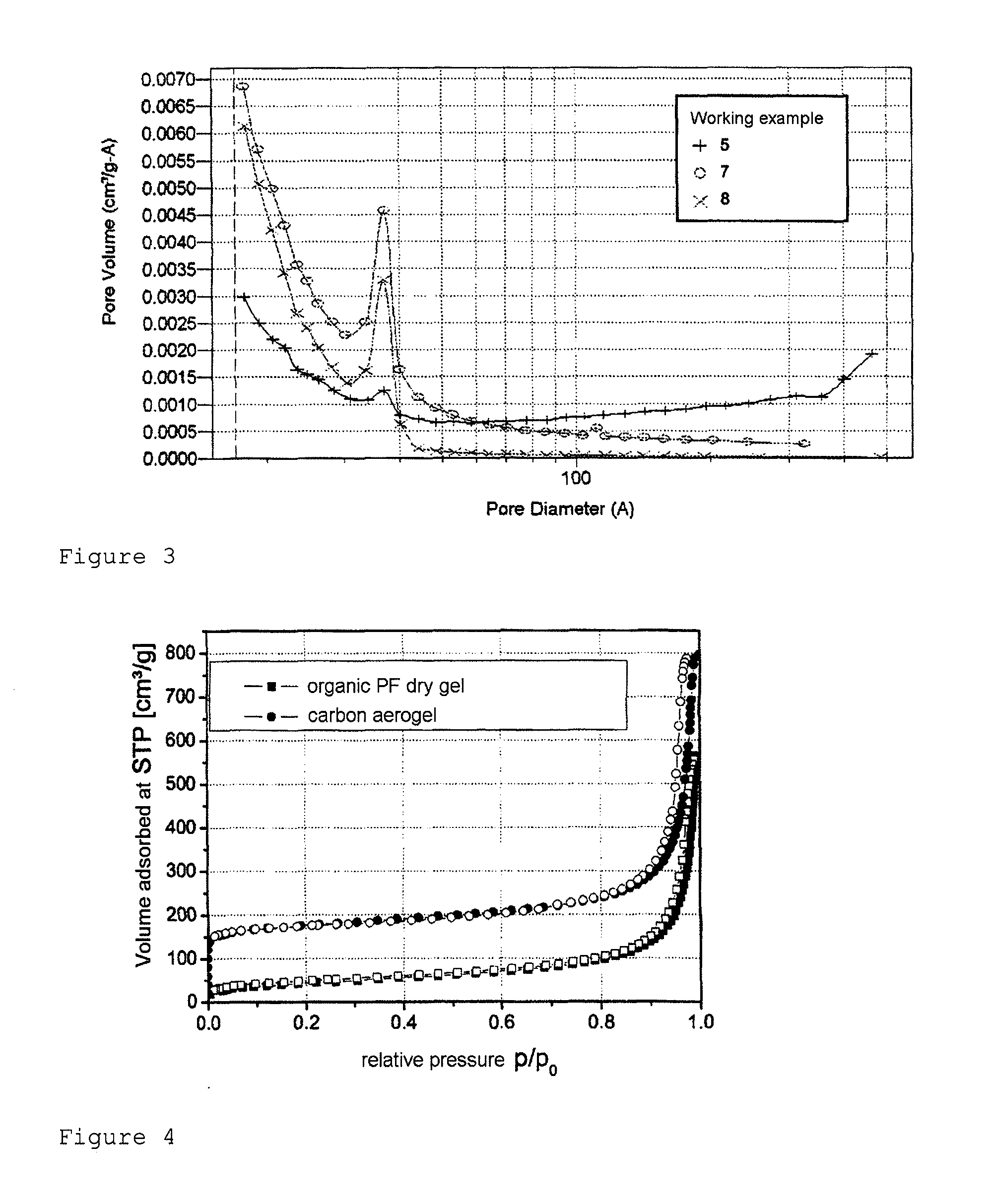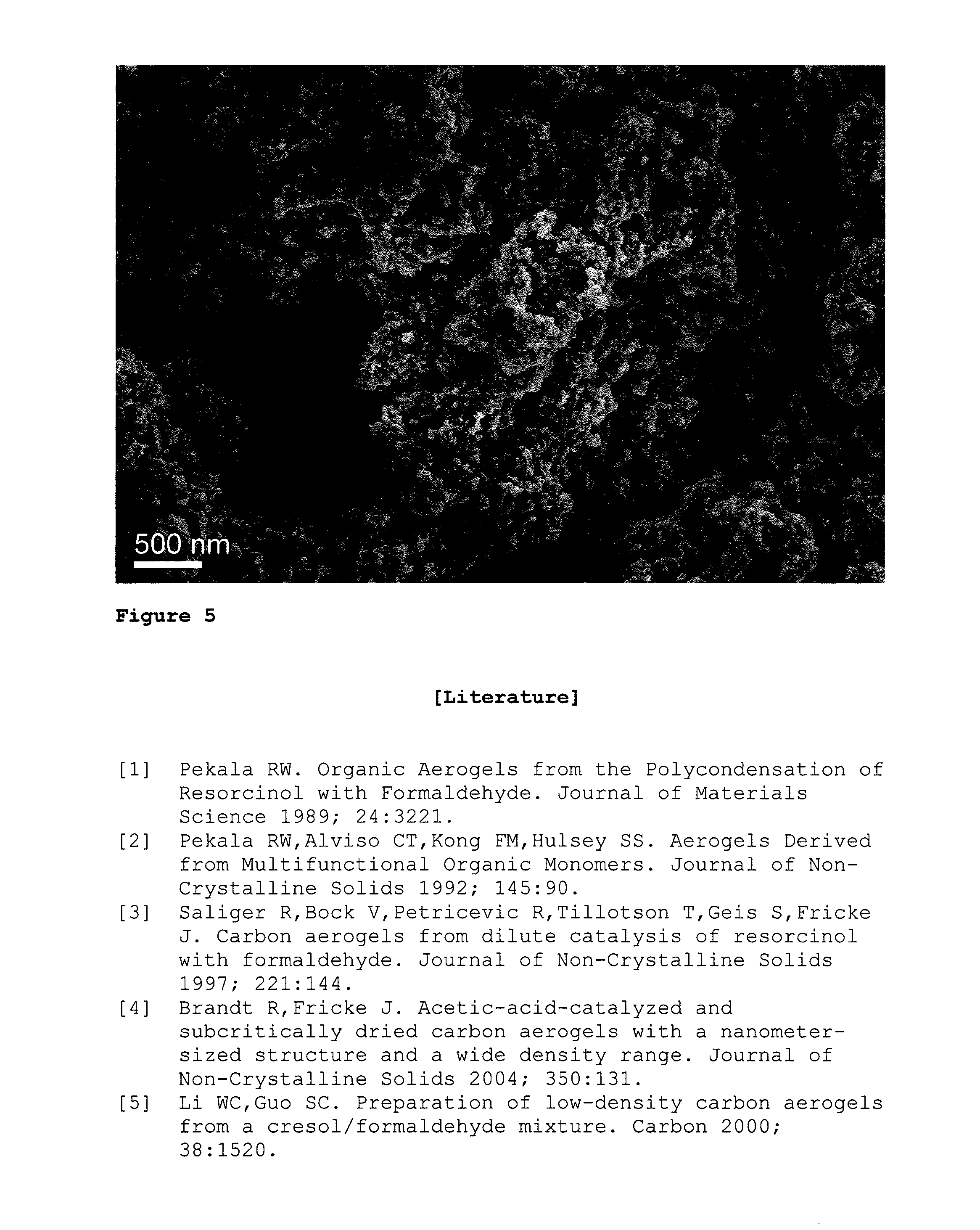Microporous and Mesoporous Carbon Xerogel Having a Characteristic Mesopore Size and Precursors Thereof and Also a Process for Producing These and Their Use
- Summary
- Abstract
- Description
- Claims
- Application Information
AI Technical Summary
Benefits of technology
Problems solved by technology
Method used
Image
Examples
working example 1
[0013]In a beaker, 3.66 g of phenol are mixed with 6.24 g of formaldehyde solution (aqueous 37% formaldehyde solution stabilized with approx. 10% methanol) and 26.27 g of n-propanol (corresponds to a molar ratio of formaldehyde to phenol of F / P=2 and a concentration of the phenol and formaldehyde reactants in the mass of the overall solution of M=15%). The solution is stirred on a magnetic stirrer until the phenol has dissolved completely. Subsequently, 3.83 g of 37% HCl are added (corresponds to a molar ratio of phenol to the catalyst of P / C=1). The solution is then introduced into a beaded edge bottle of height 10 cm (diameter 3 cm), and the beaded edge bottle is sealed airtight. The beaded edge bottle together with the sample is heated at 85° C. in an oven for 26 hours.
[0014]After 26 hours, a monolithic organic wet gel is obtained, which is subsequently dried convectively at 65° C. in a drying oven for 70 hours. A monolithic organic PF xerogel is obtained with a macroscopic densi...
working example 2
[0015]In a beaker, 6.11 g of phenol are mixed with 10.39 g of formaldehyde solution (aqueous 37% formaldehyde solution stabilized with approx. 10% methanol) and 21.38 g of n-propanol (corresponds to F / P=2; M=25%). The solution is stirred on a magnetic stirrer until the phenol has dissolved completely. Subsequently, 2.18 g of 37% HCl are added (corresponds to P / C=2.95). The solution is then introduced into a beaded edge bottle of height 10 cm (diameter 3 cm), and the beaded edge bottle is sealed airtight. The beaded edge bottle together with the sample is heated at 85° C. in an oven for 24 hours.
[0016]After 24 hours, a monolithic organic wet gel is obtained, which is subsequently dried convectively at 65° C. in a drying oven for 72 hours. This gives a monolithic, ochre-colored, organic PF xerogel with a macroscopic density of 0.48 g / cm3. The evaluation of the sorption isotherm from FIG. 4 gives a specific surface area (BET surface area) of 157 m2 / g, an external surface area of 130 m2...
working example 3
[0017]In a beaker, 6.11 g of phenol are mixed with 3.89 g of paraformaldehyde and 27.87 g of n-propanol (corresponds to F / P=2; M=25). The solution is stirred on a magnetic stirrer until the phenol and the paraformaldehyde have dissolved completely. Subsequently, 2.14 g of 37% HCl are added (corresponds to P / C=3). The solution is then introduced into a beaded edge bottle of height 10 cm (diameter 3 cm), and the beaded edge bottle is sealed airtight. The beaded edge bottle together with the sample is heated at 85° C. in an oven for 24 hours.
[0018]After 24 hours, a monolithic organic wet gel is obtained, which is subsequently dried convectively at 65° C. in a drying oven for 96 hours. This gives a monolithic organic PF xerogel with a macroscopic density of 1.00 g / cm3. The organic PF xerogel is converted to a carbon xerogel by pyrolysis at 800° C. under an argon atmosphere. The carbon xerogel thus obtained has a macroscopic density of 1.14 g / cm3, a specific surface area (BET) of 256 m2 / ...
PUM
| Property | Measurement | Unit |
|---|---|---|
| Size distribution | aaaaa | aaaaa |
| Size distribution | aaaaa | aaaaa |
| Temperature | aaaaa | aaaaa |
Abstract
Description
Claims
Application Information
 Login to View More
Login to View More - R&D
- Intellectual Property
- Life Sciences
- Materials
- Tech Scout
- Unparalleled Data Quality
- Higher Quality Content
- 60% Fewer Hallucinations
Browse by: Latest US Patents, China's latest patents, Technical Efficacy Thesaurus, Application Domain, Technology Topic, Popular Technical Reports.
© 2025 PatSnap. All rights reserved.Legal|Privacy policy|Modern Slavery Act Transparency Statement|Sitemap|About US| Contact US: help@patsnap.com



